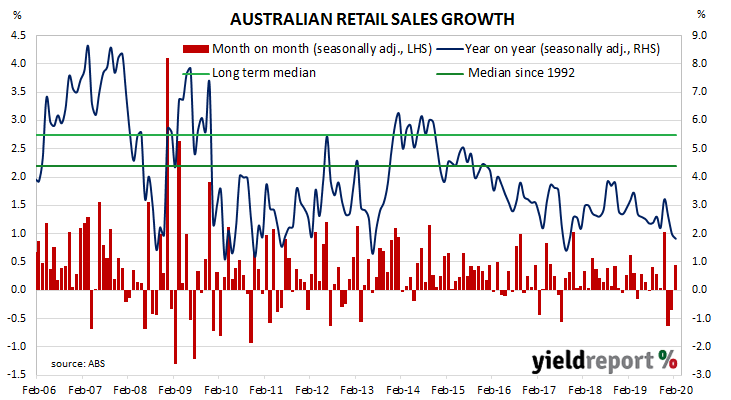Growth figures of domestic retail sales have been declining since 2014 and they reached a low-point in September 2017 when they registered an annual growth rate of just 1.5%. They then began increasing for about a year, only to stabilise at around 3.0% to 3.5% through late 2018 before trending lower through 2019. February’s figures have continued the trend and economists expect future months’ figures to deteriorate considerably.
According to the latest ABS figures, total retail sales increased by 0.5% in February on a seasonally-adjusted basis, a larger gain than the +0.4% increase which had been expected and a turnaround from January’s -0.3%. However, on an annual basis, retail sales increased by just 1.8%, as compared to January’s comparable figure of 2.0%.
Westpac senior economist Matthew Hassan said he “had expected the wash-up to be a touch softer.” Domestic Treasury bond yields reacted in a manner which was mixed but subdued. By the end of the day, the 3-year ACGB yield had slipped 1bp to 0.24% while the 10-year yield remained unchanged at 0.75% and the 20-year yield finished 3bps higher at 1.41%.
Domestic Treasury bond yields reacted in a manner which was mixed but subdued. By the end of the day, the 3-year ACGB yield had slipped 1bp to 0.24% while the 10-year yield remained unchanged at 0.75% and the 20-year yield finished 3bps higher at 1.41%.
Prices of cash futures contracts hardly moved. By the end of the day, April contracts implied a rate cut down to zero as a 55% chance, up from the previous day’s 52%. May contracts implied a 53% chance of such a move at that month’s RBA Board meeting. However, another rate reduction was not seen as being any more likely in later months of 2020; December contracts implied a 49% chance of a rate cut down to zero.

